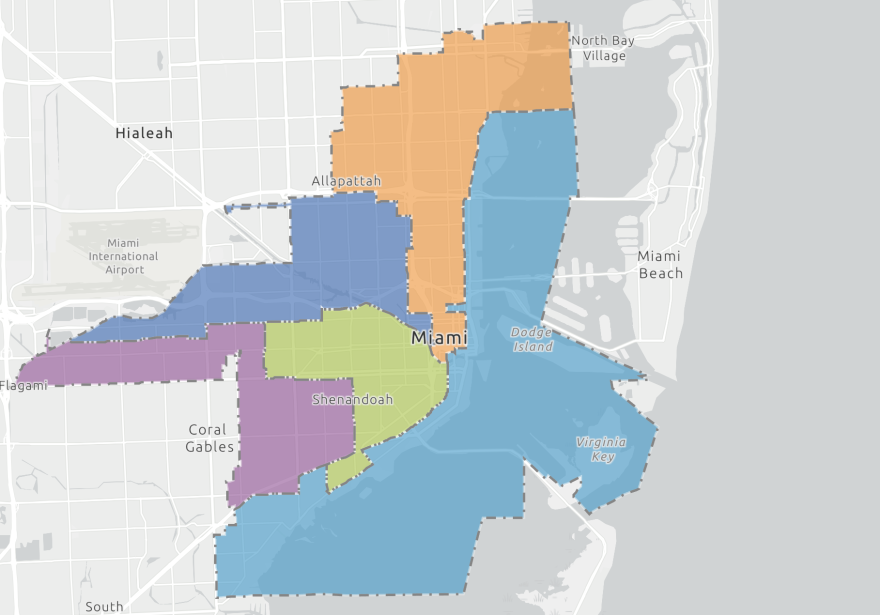More than a year after ratifying a controversial map of city districts, a federal judge has ruled that Miami has to go back to the drawing board over accusations of "racial gerrymandering."
Judge K. Michael Moore granted an injunction on behalf of the ACLU of Florida and numerous plaintiffs who sued the City of Miami in December, claiming its commission district map violated the U.S. Constitution by seeking to maintain one Black District, one white district, and three Hispanic districts.
The plaintiffs asked Judge Moore to order the city to throw out its existing map and create a new, constitutionally-compliant one, which he did early this Tuesday.
"When the record is replete with evidence that legislators instructed a mapmaker to draw districts to comport with a 'purposefully established racial target,' as is the case here, the Court may properly conclude that race predominated," Moore wrote in his order.
Moore agreed with and adopted a report and recommendation issued by a magistrate judge earlier this month, which stated stated that the plaintiffs were likely to succeed in proving that the city engaged in "racial gerrymandering," and recommended that Moore order the city to redraw its districts.
The record "before the Court contains substantial evidence that the Commission Districts are racial gerrymanders in violation of the Fourteenth Amendment," wrote Magistrate Judge Lauren Louis in a report filed in the Southern District of Florida on May 3.
Miami has five districts, each of which is represented by a city commissioner. Historically, District 5 has had a predominantly Black population, while Districts 1, 3 and 4 have been predominantly Hispanic and District 2 has been primarily mixed, with a greater proportion of white voters.
During the redistricting process, commissioners made numerous comments relating to the racial make-up of the districts while speaking to map consultant Miguel De Grandy in public meetings.
As noted in Judge Moore's ruling, Commissioner Alex Diaz de la Portilla of District 1 had said: "Our goal here is to have an African American district, for the lack of a better term, a white district, which is the coastal district, and three Hispanic districts."
For Moore and Judge Louis, these comments from elected officials were enough to prove that the plaintiffs had good reason to bring their accusations of racial gerrymandering.
"[The] Court considers the repeated, explicit statements from the majority of Commissioners in conjunction with De Grandy’s admission that he followed such instructions, and that the Enacted Plan largely preserved this racial breakdown, to be sufficient in finding that Districts 1–4 were also drawn with race as the predominate factor," Judge Moore wrote in his ruling.
READ MORE: City of Miami sued for 'racial gerrymandering' in redistricting map
In objections filed with the court, the city argued that it was not guilty of racial gerrymandering, despite the discussions by city commissioners, because the map did not increase the concentration of racial or ethnic group in any one district.
"The [report and recommendation] feels constrained to find this way, even though the redistricting did not increase the concentration of Black or Hispanic residents in any district, and instead reduced it throughout the entire redistricting plan, and even though there is no claim that the Black or Hispanic vote were diluted in any district," the city had written in a May 13 objection to Judge Louis' recommendation.
"This case is therefore unique. It throws out the entire map for racial gerrymandering because the conversation was racial, even though there was in effect no racial gerrymandering."
Judge Moore rejected the city's objections.
Now, the city must draw up new districts before November, when the next round of municipal elections are scheduled.
The redistricting process was criticized from the start back in 2021, in part because an initial draft of the map would remove a significant Black voting bloc from the western portion of the Coconut Grove neighborhood, now known as "Little Bahamas of Coconut Grove." The ratified map separated a smaller portion of Little Bahamas from the remainder of the Grove, but still split the existing neighborhood into three separate voting districts with three different commissioners.
Critics also pointed out that a strangely-shaped carve-out of Coconut Grove that was added to Miami's District 3, which is represented by Joe Carollo, included Carollo's $1.49 million property.
During his testimony in an ongoing federal lawsuit, Carollo said he has moved back in to the Coconut Grove property after the redistricting. Once the map is tossed out, he may need to leave the home and move back into his district.
The court will now direct the city and the plaintiffs to a mediation and status conference session, where they must discuss a timeline to create a constitutionally compliant map.






